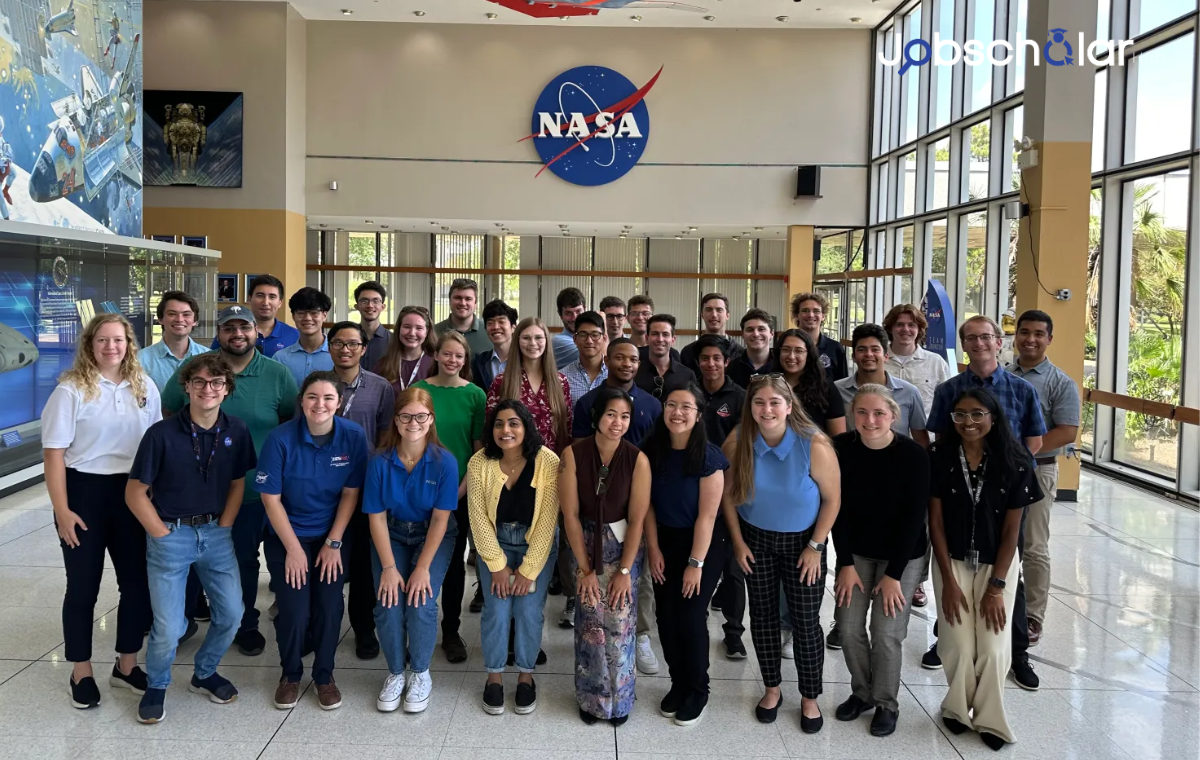Do you wish to start your career with one of the world’s most prestigious space organizations? NASA Internship 2025 gives you the opportunity of a lifetime to work with some of the brightest scientists, engineers, and other professionals in the world who are pushing boundaries in human knowledge.
Very much an open door for a high school pupil keeping stars in his eyes or for graduate students possessing specialized skills, knowing how to apply for NASA internship positions could be your first stepping stone into an extraordinary career. Continuing with the agency’s long tradition of providing students with hands-on experiences that build confidence, technical skills, and readiness for careers all in the context of missions that inspire humanity, the NASA Internship 2025 program continues to do so.
Each year, NASA’s Office of STEM Engagement places more than 2,000 interns into hands-on experiences that directly advance the groundbreaking work of the agency within science, technology, aeronautics, and space exploration. Not just hobby experiences that go on a resume, these are life-altering experiences through which you contribute to true NASA projects under the guidance of expert mentors.
Later, when you are talking to potential employers, you can claim that you analyzed data from a Mars rover, developed onboard software for the International Space Station, or contributed to new designs for spacecraft-all before you graduate!
The benefits of gaining a NASA internship span far wider than just technical know-how gained through the program. You’ll be ushered into the circles of professional networking by industry leaders, empowered through confidence to believe in yourself, and possibly doors will open for future employment with NASA or other aerospace organizations.
The Pathways program actually allows for internships, setting up direct pipelines into full-time jobs with NASA after graduation. As everyone knows, Vault.com recognized NASA’s internship program as the most prestigious of them all. NASA has propelled countless students and early-career professionals into successful routes in aerospace and beyond.
So it is now time to learn everything about how to get into this competitive program, as the Fall 2025 application deadline, which is May 16, 2025, will soon be upon us. Let’s see not only the types of internships but also who is eligible to apply, how the application process works, and the insider tips you can use to stand out from the crowd of talented applicants.
Types of NASA Internships
When talking about NASA, many people conjure up the visions of rocketeers and astronauts. Of course, the importance of such roles cannot be understated; however, NASA’s mission requires specialists from what seems like every imaginable academic discipline. NASA conducts its own internship programs spanning an amazing variety of fields, making it possible for students from so many diverse academic perspectives with equally diverse aspirations to apply.
STEM and Engineering Opportunities
Traditionally, NASA’s primary strength lies along the lines of science, technology, engineering, and mathematics (STEM). Engineering internships range across specialties such as aerospace, mechanical, electrical, and computer engineering, usually engaging in activities associated with spacecraft design, propulsion systems, robotics, or simulation technologies. Science internships can encompass physics, astronomy, geology, chemistry, and biology-all important for NASA’s missions in exploration and discovery.
Technology and computing positions are gaining in importance on account of NASA’s newfound emphasis on pushing the frontiers of data analysis, artificial intelligence, and computational power. Interns in these functions could work on everything from machine learning algorithms for enhanced satellite image analysis to developing software that controls space systems.
Beyond Traditional STEM Fields
A common misconception is that NASA only offers engineering internships, but this couldn’t be further from the truth. NASA actively recruits students from diverse academic backgrounds including business administration, accounting, finance, communications, public affairs, and human resources. These “non-engineering” interns support vital business and program management functions like procurement, budgeting, accounting, IT, and security.
At the NASA Glenn GVIS Lab, for example, internships focus on areas like augmented and virtual reality (AR/VR), 3D modeling, social media, and technical writing. These positions recognize that effective science communication and management are just as important to NASA’s success as technical innovation.
Related: Data Science Internship 2025: How to Apply, Requirements, and Tips
Hybrid and Location-Based Opportunities
NASA internships take place at different centers of the agency throughout the United States. Each center focuses on very specific specializations and projects based on their respective focus within the mission of NASA. Wherever possible, most internships will require on-campus presence in these facilities, while some might allow hybrid or even remote options, especially in computational or data analysis fields.
Such a variety of opportunities shows how NASA approaches its mission in a very holistic manner. By convening specialists from diverse disciplines, NASA generates the teamwork necessary to confront humankind’s greatest exploration challenges.
Eligibility Requirements
Before application, it is important to check on eligibility status for a NASA internship. Minimum qualifications will generally ensure that all selected candidates will benefit from and contribute well to NASA’s operation.
Internships with NASA always attract thousands of people each year, and it is among some of the most competitive opportunities out there. However, from knowing the eligibility criteria, candidates will be able to identify what they need to determine if they fulfill those requirements before investing time in applying.
Citizenship
Most NASA internships will ask that a candidate be a citizen of the United States. That is mostly true with respect to all Office of STEM Engagement (OSTEM) internships and Pathways programs which are only open to citizens of America. This particular requirement applies mostly to those projects that NASA is handling that are sensitive in nature and subject to various security protocols at NASA facilities.
However, if you are an international student, do not lose hope! After all, NASA has special internship opportunities for international citizens from countries having current agreements with the agency. These types of positions are usually in STEM areas aligned with NASA’s priorities and require candidates to prove their academic qualifications and proficiency in English.
Age
All NASA internship applicants have to be at least 16 years of age at the time of application, with no exceptions to this rule. This is a minimum age requirement that applies across all internship categories and NASA centers.
Academic Status
NASA internships are principally targeting students at all educational levels. For OSTEM internships, applicants should be a full-time student (high school through graduate levels) or part-time college students enrolled with at least six semester hours. In some cases, currently employed teachers may also apply for OSTEM opportunities.
For Pathways internships, requirements are slightly different. You must be a degree or certificate-seeking student currently enrolled or accepted for enrollment in an accredited educational institution on at least a half-time basis. You also should have completed at least 15 semester hours or 23 quarter hours and will have to complete at least 480 work hours before graduation or completion of certification requirements.
Academic Performance
NASA values academic excellence and typically requires a minimum GPA of 3.0 on a 4.0 scale for OSTEM internships. This threshold for tracking student GPA under Pathways internships differs slightly in that it is placed slightly lower at a 2.9 GPA under the 4.0 scale. The difference shows that the two internship programs function serve different intents and structures.
Related: Spotify Internship 2025: How to Apply, Requirements, and Tips
Field of Study
However, there may be a few internships that require coursework or academic backgrounds specific to the particular project. For example, an international internship would generally have an eligibility criterion that students must be pursuing an undergraduate or graduate degree in a STEM field relevant to NASA’s mission priorities.
It is also important to note that NASA cherishes diverse thoughts and perspectives, so this agency would actually welcome candidates from students not studying disciplines in science, technology, engineering, and mathematics. It needs exceptionally talented people in majors that fall in business, communications, and project management for the fulfillment of its multifaceted mission.
Deadline for Applications
Timing is everything when applying for NASA internships. An application may be missed by the deadline, and it will take another several months before the next opportunity comes around; thus, it’s imperative to know when to apply in order to plan your NASA internship journey.
NASA internship operates on a three-session cycle throughout the year. Each session has its own experiences and projects. Knowing these deadlines well in advance gets you ample time to prepare a competitive application.
Summer Session
The Summer session has always been treasured as the most popular and competitive internship period at NASA. For Summer 2025, application deadline was set at February 28, 2025. This particular period has passed, leaving prospective interns with the focus on the Fall 2025 or later sessions.
Summer internships run for 10 weeks from late May or early June through August. Because the internships align with the traditional summer break, when students are not in school, they can serve prospective interns who aren’t able to participate during the academic year.
Fall Session
The next immediate opportunity will be for the Fall 2025 session, of which the application deadline is May 16, 2025 – which is just less than two weeks from now. Fall internships tend to last around 16 weeks and are generally between late August or early September to mid December.
Since fall internships coincide with academic semesters, they may include an opportunity for earning academic credit depending on your institution policies. Fall internships are generally not very much sought after. This will translate into bigger chances of selection.
Spring Session
The next planned-in session is Spring 2026, where the application deadline will fall on September 12, 2025. Spring internships typically last about 16 weeks, running from mid-January through early May.
Similar to the fall, spring internships are likely to be in sync with a college semester. However, spring internships are expected to be even less competitive than summer internships.
Planning Ahead
For students in advanced planning, NASA has also publicized the application deadline for Summer 2026: February 27, 2026. Having these dates so far in advance gives you an opportunity to prepare application materials, secure recommendations, and step up qualifications before the deadlines kick in.
Related: Externship vs Internship: What You Need to Know, How to Apply, Requirements, and Tips

How to Apply for NASA Internship
The NASA internship application process is simple to navigate but can only survive if one painstakingly dot all i’s and crosses all t’s. Following these steps will make certain your application is given every consideration in this esteemed program.
Applying for a NASA internship involves more than the simple submission of a form. It involves strategic thinking and preparation of application materials, and a sincere knowledge of how your skills and interests align with NASA’s mission and specific projects.
Step 1: Prepare Your Documents
Begin the application process only after you have put yourself in the best possible position by gathering all necessary materials:
Resume/CV: A clear, concise resume outlining your relevant coursework, project, skills, and experiences. This document should be tailored so that it brings out the qualifications which closely match the particular internships that you have in mind.
Academic Transcripts: Most internships require unofficial transcripts that document their courses and indicate academic performance; they may also require official ones after applicants are selected.
Statement of Purpose: Otherwise called a personal statement, this essay articulates your reason for applying for a NASA internship; your relevant skills and experiences; and how this internship connects with your future career goals. The statement should reflect your enthusiasm for NASA and identify contributions you can make.
Recommendation Letters: Obtain two or three recommendation letters from professors, advisors, or employers who can attest to your qualifications, work ethics, and potential. Give your recommenders plenty of advanced notice and give them a brief description of the internships you are aiming for.
Step 2: Research Opportunities
Now that the documents are ready, it is time to see what internships are available:
Search for opportunities on the NASA internship web portal at intern.nasa.gov. NASA STEM Gateway allows you to filter positions with the search tool by locations, fields, academic levels, or any other matching criteria that best describe your interest and qualification.
Read carefully all project descriptions so that you know what specific skills, experience, and academic background are being sought for each opportunity. Be mindful of any particular requirements or preferences indicated in the listings.
Consider applying for more than one position that fits your qualifications, as this will enhance your chances of being selected, but do so only on the positions you are truly interested in and qualified for.
Step 3: Create an Account
Register on the NASA internship portal and thoroughly complete your profile:
Fill in all profile sections, such as educational background, relevant coursework, skills, and experiences. This information will support the matching of applicants with suitable opportunities.
The primary form of communication will be through the email provided on the application. Thus, ensure that your contact information is accurate and that it is a professional email address, which you check regularly.
Step 4: Complete and Submit Application
With your account created, now apply to specific internships:
Make sure that you fill in your application form correctly according to the instructions given. The attention-to-detail process is highly respected.
Upload all documents as required and in the specified format. Please make sure that all documents are presented in a complete, professional manner, and free of typographical errors.
Each internship position might require different specifications, so double-check the conditions for each position if applying to several internships.
Submit the application well before the deadline to rule out any system glitches or last-minute surprises. The system shuts down precisely at the deadline (typically 11:59pm. EST).
Related: Microsoft Internship 2025: How to Apply, Requirements, and Tips
Step 5: Interview Preparation
If successful enough to proceed past the screening stage, and if selected, you will be invited by NASA mentors to interview:
Prepare for both technical field-oriented questions and behavioral questions regarding teamwork and problem-solving, as well as motivation towards joining NASA.
In addition, take time researching the specific NASA center, department, and project you’ve applied for, so that you may speak knowledgeably and passionately in the interview.
Practice being able to articulate your experiences, skills, and career goals concisely. And be prepared to spell out your contributions towards NASA’s mission.
Tips for a Successful Application
It takes strategic preparation and authenticity to stand out amongst the multitude of highly competitive applicants. With these insider tips, you are well on your way to being selected for a NASA internship.
Very few positions are available amongst the numerous qualified candidates for NASA undergraduate internships. Basic eligibility will get your foot in the door, but these things can help your application rise above the rest.
Start Early and Keep the Deadlines
- Start preparing your application as much in advance as possible before the deadline. This way, you will leave yourself enough time to get the most powerful application materials you can, gather real recommendations, and be able to deal with any last-minute challenges that may come up.
- Set personal deadlines several days before official deadlines to account for technical issues or last-minute revisions. Late applications are not accepted under any circumstances, regardless of the reason.
Tailor-Made Application Materials
- Adapt your resume and your statement of purpose to the specific internship position. Focus on the experience, skills, and coursework that are most relevant to the project or role.
- Learn about the NASA center and the department that offers the internship in order to have an idea about their mission, projects, and needs. Refer to that in your application to prove sincere interest and preparation.
- Include keywords from the description of the internship in your application materials so that reviewers can easily trace your qualifications.
Acquire Experience that Matches the Expectation
Although formal experience may not be a requisite, the display of initiative and relevant skill enhances your application considerably:
- Participate in school clubs, competitions, or research projects related to your field of interest.
- Develop technical skills through coursework, online learning, personal projects, or previous internships.
- Seek opportunities for volunteerism in community service activities that could develop teamwork, leadership, and problem-solving abilities valued by NASA.
Seek Guidance and Mentorship
Find mentors – professors, advisors, or professionals whose work aligns with the guidance you want in your application:
- Ask your mentors in the field for feedback on your resume and personal statement.
- If you can, reach out to former NASA interns to see if they can share about their application process or experience with their projects.
- Make use of your university’s career services office for further assistance in applications and interview preparations.
Show Commitment to NASA’s Mission
Demonstrate an earnest keenness to space travel, scientific discovery, or the specific applications of the NASA center that you desire:
- Explore current missions and initiatives of NASA that you could reference in your application materials and interviews.
- Keep abreast with NASA news and follow their social media accounts and publications so as to be updated with what is happening.
- Clearly state how your personal and professional aspirations meet NASA’s mission and that of the internship project’.
Developing Both Technical and Soft Skills
NASA tries to find candidates who are well-rounded, bringing through not only technical skills but also soft skills:
- For example, teamwork experience as NASA projects always involve high collaboration with other disciplines.
- Show examples of overcoming challenges in academic or personal projects to demonstrate problem-solving abilities.
- Develop communication skills in clearly breaking down complex ideas.info, making clear that this indeed is a great asset in any NASA position.
Related: Marketing Internship 2025: How to Apply, Requirements, and Tips
Benefits of a NASA Internship
NASA internships are such an excellent opportunity that it is much better than just another line on your resume. Such experience can transform one’s educational journey into a very interesting career pathway.
The NASA internship isn’t the experience today, but an investment for the future with dividends ever paying during the course of your career in both probable and improbable ways.
Hands-on Project Work Experience
While some internships might come primarily with administrative functions, NASA interns actually work on projects in the agency that have real-world significance. You assist in designing spacecraft components, analyzing data from space missions, developing new technologies, or researching to advance our knowledge about Earth and space.
Such experience in direct contact with theoretical knowledge teaches the development of technical skills that could be put to immediate use in an industry scenario. The tasks are set to be difficult, thus forcing you to apply theoretical concepts to real-life problems.
Mentors and Guides Stanford
NASA interns are under the mentorship of experienced professionals who are leaders in their fields. Technical guidance and advice for one’s career will be provided by these mentors while helping the intern navigate the environment professionally.
The learning experience from successful scientists, engineers, and administrators gives you insights that simply can’t be found in a classroom setting. Many times, these mentorship opportunities transcend the internship, creating what will be more valuable links in your career.
Developing Professional Networking
Connecting with other interns, NASA employees, and contractors from different disciplines and levels in their careers is part of your internship experience. This connection will become the foundation of your professional network, invaluable in future job opportunities, collaborations, and knowledge sharing.
Apart from that, there will also be networking events, speaker series, and social activities wherein interns will be establishing interrelationships across the agency. Most likely, these would lead to future internship placements, job references, or research collaboration.
Career Flexibility and Job Opportunities
A NASA internship enhances any resume and career portfolio given to an employee, within NASA and outside the agency, as pertains to the whole aerospace industry. NASA experience for many employers connotes great ability, a strong work ethic, and high potential.
This is mainly because most of NASA’s Pathways Internship Program is tailored to prepare interns for a permanent job at NASA upon their graduation. The name NASA with any employee carries great value among employers globally, even for those who venture into other career paths.
Skill Development Beyond Technical Knowledge
While technical skills are certainly developed during NASA internships, participants also build crucial “soft skills” demanded by employers:
- Problem-solving abilities are honed through tackling complex, open-ended challenges with real constraints.
- Communication skills develop as you learn to explain technical concepts clearly to diverse audiences.
- Teamwork experience comes from collaborating with multidisciplinary teams on projects larger than any individual could accomplish alone.
- Project management abilities grow as you work within timelines, budgets, and specification requirements on real NASA initiatives.
Personal Growth and Inspiration
Perhaps the most profound benefit is the perspective gained from contributing to humanity’s exploration of space. NASA interns frequently report that their experience filled them with purpose, expanded their sense of possibility, and clarified their career aspirations.
Working at an agency dedicated to pushing boundaries and expanding human knowledge creates a unique environment that inspires excellence and innovation. This experience often ignites a lifelong passion for exploration and discovery that shapes career choices for decades to come.
Conclusion
Applications for NASA internships for the year 2025 are indeed a portal to participate in what is perhaps the greatest adventure ever-humanity’s exploration of space and advancement of scientific knowledge. The application itself is quite the exhaustive process; however, the benefits alone make it worthwhile. As you understand the eligibility criteria, prepare well, and submit a highly competitive application before the deadlines, you position yourself for an experience that can truly be life-changing educationally and professionally.
Whether it be engineering, science, business, or communications or in another field entirely, at NASA, you can truly contribute to fulfilling its mission. The Fall 2025 application deadline is set for May 16, 2025, fast approaching enough to allow ample time to prepare and submit a competitive application. And if you are looking much further ahead, the Spring 2026 deadline is September 12, 2025, and the Summer 2026 deadline is February 27, 2026.
NASA champions its diversity of thought, background, and experience when they build the teams to execute its space exploration endeavors. Perhaps your unique perspective and skill-set-when complemented with enthusiasm, preparation, and persistence-will be the missing link NASA seeks in its interns of choice. What lies ahead for you, should you dare apply and come at it with all your commitment, is to work amidst brilliant minds, contributing to cutting-edge programs that may seal a life-long launch window into the heart of human discovery.
Frequently Asked Questions
Absolutely! While NASA is known for its engineering and science opportunities, the agency actively recruits students from diverse academic backgrounds including business administration, accounting, communications, social media, technical writing, and human resources.
NASA internships are highly competitive, with thousands of applications for limited positions each session. To improve your chances, start by maintaining a strong GPA (at least 3.0), customizing your application materials for specific positions, gaining relevant experience through clubs or projects, securing strong recommendation letters, and demonstrating genuine passion for NASA’s mission.
Yes, NASA internships are paid positions. OSTEM interns typically receive stipends based on their academic level and session duration. Pathways interns are hired as federal civil servants with corresponding benefits. Beyond compensation, all NASA interns receive invaluable benefits including hands-on project experience, expert mentorship, professional networking opportunities, and potential pathways to future NASA employment.
Yes, international students can apply for NASA internships, but with specific limitations. While OSTEM and Pathways internships require U.S. citizenship, NASA offers international internship opportunities for citizens of countries with current agreements with the agency.
References
Recommendations
Morgan Stanley Internship: How to Apply | The Ultimate 2025 Guide
Internship in Spain 2025: How to Apply, Requirements, and Tips






